calsfoundation@cals.org
A Tale of Two Memorials
Guest post by Bernadette Cahill:
“They went and told the sexton, and
The sexton toll’d the bell.”
–Final couplet from “Faithless Sally Brown,” by Thomas Hood (1799–1845)
These words echoed in my mind in 2021 when my husband Ron and I arrived at Oakland & Fraternal Historic Cemetery Park at 2101 Barber Street in Little Rock to take fresh photos of the grave of Arkansas’s leading nineteenth-century suffragist, Clara Alma Cox McDiarmid (1847-1899). I first photographed her gravestone more than a decade ago, but I wanted a new image to illustrate a point.
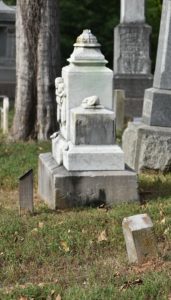 From Clara’s significance in history and from the picture, it would seem logical that the ornate memorial in the background is Clara’s: she was well known not just here, where her death and funeral featured prominently in the Arkansas Democrat and Arkansas Gazette, but also across the nation and internationally for her advocacy of women’s suffrage, education, and general well-being, as well as for temperance.
From Clara’s significance in history and from the picture, it would seem logical that the ornate memorial in the background is Clara’s: she was well known not just here, where her death and funeral featured prominently in the Arkansas Democrat and Arkansas Gazette, but also across the nation and internationally for her advocacy of women’s suffrage, education, and general well-being, as well as for temperance.
Certainly, as I first approached her gravesite, I assumed that the large memorial was for her. But the reality upset me.
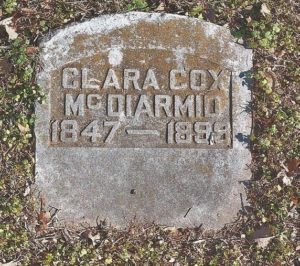
Instead, hers was the tiny stone in the foreground—out of scale for a woman so important in Arkansas’s women’s history. In fact, when I first photographed Clara’s stone back in 2011, it was just a marker embedded in the ground. The contrast between this small horizontal stone and the elaborate memorial beside it, therefore, was even greater then than today.
The ornate memorial was in fact for Lillie and Katie, children of George W. and Clara A. McDiarmid. The story is tragic. Lillie died on November 17, 1871. According to the cemetery register, which volunteer Linda Howell showed me, their bereaved father bought Plot No. 390 the next day.
We do not know if he anticipated a second funeral, but given the deadliness of so many childhood diseases at the time, likely he and Clara were worried. They had reason to be, for Katie died less than two weeks after her sister, on November 30. Lillie was four years and three months, Katie two years and four months. Both notices appeared in the Gazette.
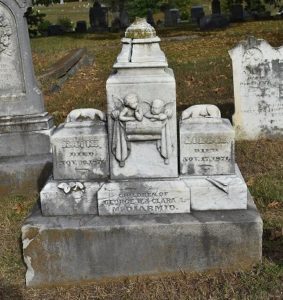 The McDiarmids were well off, with George from a wealthy family and serving as Pulaski County Clerk. They owned property in Argenta, just west of downtown North Little Rock, in what was then known as the McDiarmid subdivision. They could afford and might have been expected to erect an elaborate memorial for their two children to demonstrate their love for Lillie and Katie and their grief at their deaths, so tragically young, so tragically close together in time.
The McDiarmids were well off, with George from a wealthy family and serving as Pulaski County Clerk. They owned property in Argenta, just west of downtown North Little Rock, in what was then known as the McDiarmid subdivision. They could afford and might have been expected to erect an elaborate memorial for their two children to demonstrate their love for Lillie and Katie and their grief at their deaths, so tragically young, so tragically close together in time.
By contrast, when Clara died in Des Moines, Iowa, almost thirty years later on July 22, 1899, her Little Rock attorney son George C. McDiarmid accompanied her body home on the Cannon Ball train. By then her husband had for many years been in an insane asylum.
George C. was very close to his mother, sometimes participating in her women’s rights work. His office was possibly the location of the reputed sign advertising free legal advice for women mentioned in a newspaper article years later.
Why, therefore, instead of marking only her name and dates on a small gravestone, did George C. not memorialize her with a large monument reflecting her prominence and carved with some reference to her work? This is a mystery that haunts Clara’s grave and haunted me.
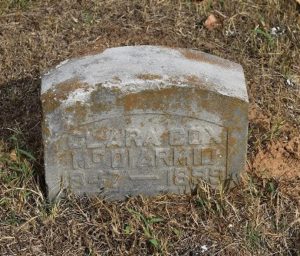
However, I had a surprise on revisiting the grave to photograph it together with the large monument. Clara’s stone was upright! John Rains, Oakland Cemetery sexton, told me he had raised it about seven years ago in preparation for one of the cemetery’s famous “ghost tours.” The stone in its original vertical position, though still out of scale with Clara’s prominence and still largely uninformative, now felt somewhat more appropriate, and it was gratifying it had been cared for.
Then hearing that Mr. Rains was the sexton, the closing couplet of the old nonsense poem that my father delighted in entertaining us with as children crept out of my memory, which was a bonus of the long trip to Little Rock.
The tale of these two memorials tells us that, first, we cannot assume that the largest stone in a family gravesite is the most important. Second, it shows that monuments can mislead. The elaborate children’s monument marked two little girls who sadly never had the chance to live their full lives. The simple marker with name and dates tells only of a woman who died at fifty-two, revealing nothing of her life spent in contribution to the welfare and advancement of women.
This incongruence is understandable: at the time of a death, family members are not thinking about people of the future who might want information; they are thinking about those who have passed and are lost forever. But it is sad that Clara McDiarmid’s grave marker tells so little because it reveals so little to the casual visitor.
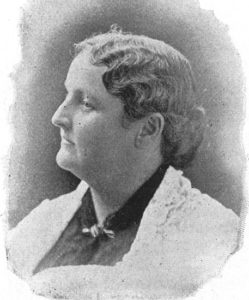
Prominent people, however, usually leave some sort of paper trail from which to find more detail of their lives. With Clara, the starting point for genealogists may have been a family story. In my case, reports of her activities in the newspapers during historical research led me eventually to her grave. For visitors, the Oakland Cemetery office has some documentation on Clara, which is also included in the free phone tour.
Further reading about Clara McDiarmid and women’s suffrage by Bernadette Cahill:
“Arkansas History Mystery Solved.” Butler eBanner (Spring 2016): 4.
Arkansas Women and the Right to Vote: The Little Rock Campaigns, 1868–1920. Little Rock: Butler Center Books, 2015. (Order at: https://www.uapress.com/product/arkansas-women-and-the-right-to-vote/)
“Carved Only with Her Name: Clara McDiarmid and Woman Suffrage in Arkansas.” Pulaski County Historical Review 64 (Summer 2016): 69–73.
“The McDiarmid House: Early Ownership History of a Significant Structure in 19th-Century Little Rock.” Pulaski County Historical Review 59 (Winter 2011): 122–126.
“The Only White Man in the Procession: George W. McDiarmid, Pulaski County Clerk.” Pulaski County Historical Review 62 (Winter 2014): 122–129.
***
For deep dives into the subject of women’s suffrage, check out the new CALS Women’s Suffrage Book Club, a monthly book discussion series from April 2022 through August 2022 focusing on texts about the Women’s Suffrage Movement in the United States. Each of the five sessions, held virtually on Zoom and live streamed through the CALS YouTube channel, will include a brief presentation by a local scholar followed by a discussion of the book. Participants are welcome to attend any or all of the monthly book discussion groups, registering for each individually. More info. here.




